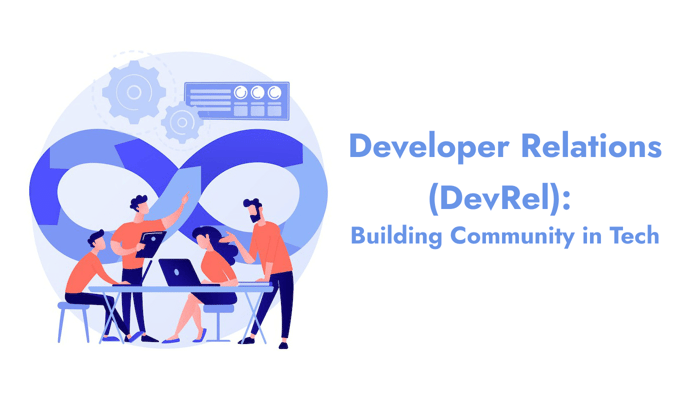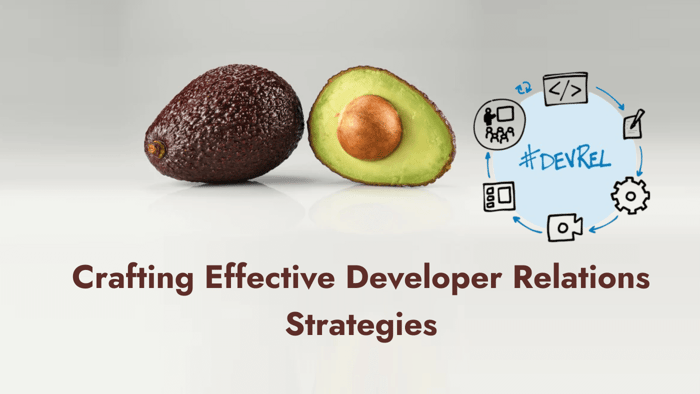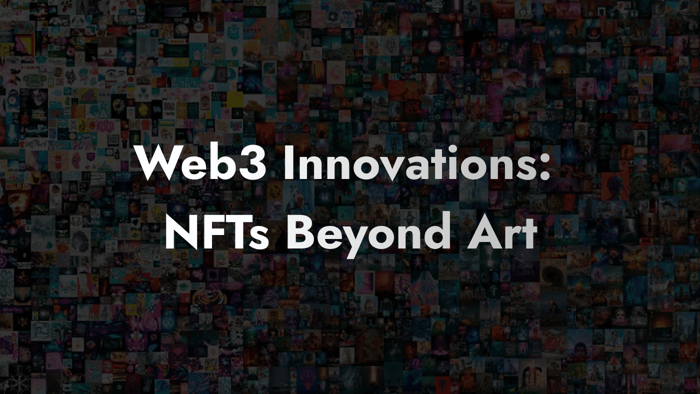Learn about building developer communities in tech
The tech industry has witnessed a significant shift in recent years, with community building evolving from a niche activity to a cornerstone of a successful company's strategy. This transformation is fueled by the growing recognition of Developer Relations (DevRel), a specialized practice focused on fostering meaningful connections and collaboration between developers and technology companies.
DevRel encompasses a range of activities, from creating informative content and organizing engaging events to providing technical support and actively soliciting feedback from developers. By establishing a strong DevRel presence, companies can cultivate a vibrant community of engaged users who not only contribute to the product's development but also act as brand advocates and drive long-term success.
Historically, the tech industry has seen a shift from traditional brick-and-mortar operations to cloud-based services, significantly increasing the demand for developers. This change underscores the importance of DevRel, as developers tend to form their unique communities with specific values and are not easily swayed by standard marketing. Thus, DevRel has emerged as a crucial strategy for engaging this distinct audience, offering support, and fostering a sense of belonging and growth within the community.
Moreover, the transition from seeing community building as a niche activity to recognizing it as a central strategy for tech companies highlights the evolution of DevRel. It is no longer just about promoting products but about creating ecosystems where developers feel valued, heard, and motivated. This nurturing approach helps align developers' interests with those of the company, thereby driving innovation, product adoption, and community growth.
In essence, the significance of DevRel in the tech industry cannot be overstated. It has become integral to fostering innovation, engaging with developers on a deeper level, and building thriving communities supporting mutual growth and adopting new technologies successfully.
What is Developer Relations (DevRel)?
DevRel, short for Developer Relations, is a strategic approach that focuses on building mutually beneficial relationships, understanding, and engagement between technology companies and the developer community, rather than mere product promotion.
The primary objective of DevRel is aimed at the following:
- Educating developers about a company's products and APIs.
- Ensuring customer success by providing technical support and guidance to developers using the company's tools.
- Building an engaging developer experience with the community of developers around the company's technology.
- Gathering feedback from developers to improve the company's products and services.
To achieve this objective, the following roles are responsible::
- Developer Advocates: These individuals act as the face of the company for the developer community. They provide technical expertise, create educational content, and participate in industry events.
- Evangelists: Evangelists are passionate about a company's technology and promote its adoption through speaking engagements, workshops, and other outreach activities.
- Community Managers: Community managers are responsible for building and nurturing the developer community around a company's technology. They facilitate communication, organize events, and address community concerns.
By investing in DevRel, companies can cultivate a thriving developer community that drives innovation, adoption, and long-term success.
Traditionally, developer engagement was often an afterthought for tech companies and emerged as a response to the unique characteristics of the developer community, which values authenticity, technical excellence, and community support over traditional marketing approaches. However, in recent years, DevRel has become increasingly recognized as a critical function for several reasons:
- The rise of open-source software and developer ecosystems: As collaboration and open-source development have become more prevalent, companies need to actively engage with developers to ensure their products are adopted and integrated effectively.
- The growing importance of developer experience (DX): Developers have more choices than ever, and companies need to prioritize creating a positive and productive experience for them to use their products and services.
- The need for continuous feedback and innovation: DevRel provides a valuable channel for companies to gather feedback from developers and use it to inform product development and innovation efforts.
Developers are generally known for their scepticism of marketing techniques. They prefer engaging with people who can understand their challenges and provide genuine solutions and value. DevRel professionals often have technical backgrounds themselves, which enables them to connect with developers authentically and advocate for them.
The importance of DevRel in tech companies has increased as businesses recognize the direct correlation between an engaged developer community and the success of their products.
The Four Pillars of Developer Relations
Tech communities are founded on four key pillars, which play a crucial role in ensuring their growth and sustainability. These pillars serve as the building blocks for a thriving tech community and are essential in defining its success.
The four pillars are as follows:
- Outreach: This pillar focuses on activities aimed at driving awareness and understanding of a product, ultimately leading to user acquisition and retention. It encompasses both online and in-person efforts to make potential users aware of the product, address their concerns, and guide them towards committing to its use. Effective outreach tactics play a crucial role in bridging the gap between product awareness and adoption.
- Community: A vibrant and engaged community around a developer-targeted product serves as evidence of its usage and amplifies the efforts of developer relations programs. It provides a framework for developers to be successful with the product, offering social proof, additional support, and supplemental activities. Community-building efforts are essential in moving developers through the acquisition to product stages of the user journey, fostering a sense of belonging and collaboration among users.
- Product: This pillar encompasses the role of developer relations teams in shaping and delivering the product. Developer advocacy involves advocating for the product to developers while also representing the voice of developers within the company. DevRel teams may directly contribute to product development by creating SDKs, integrations, and other elements of the developer experience. Their role in the product focuses on moving users from initial activation to becoming active and committed users.
- Education and Support: This pillar encompasses activities related to educating, supporting, and enabling developers to become productive on the platform. Depending on the company's structure, these responsibilities may be shared among different teams or fall under the purview of the developer relations team. Education and support efforts are crucial for guiding developers through the user journey and ensuring they have the resources and assistance needed to succeed.
These pillars collectively provide the foundation for a thriving tech community, fostering innovation, collaboration, and empowerment among its members. By prioritizing outreach, community-building, product development, and education/support initiatives, tech communities can inspire, educate, and empower individuals across the digital landscape.
Why Developers Join Communities
Software developers are often motivated to join communities due to various psychological and pragmatic factors that fuel their eagerness to network, learn, and evolve within a supportive environment. The following are some factors that motivate developers to join tech communities:
- Learning: Developers often join communities to enhance their knowledge and skills. These communities provide a conducive environment to learn new technologies, programming languages, and best practices. Codecademy and freeCodeCamp are websites that offer interactive tutorials and structured learning paths to help developers acquire new skills at their own pace.
- Career Growth: Communities offer a conducive environment for developers who want to progress in their careers. They offer numerous networking opportunities, which allow professionals to meet potential mentors, collaborators, and employers. Platforms such as LinkedIn and Meetup provide avenues for networking events, workshops, and job postings that cater to the tech industry, empowering developers to explore career opportunities and establish valuable connections. Communities act as a springboard for professional development, providing access to experienced developers, mentorship opportunities, and valuable learning resources. By working on projects collaboratively within the community, developers can gain practical experience, showcase their abilities, and potentially discover new job prospects.
- Sense of Belonging: In an increasingly interconnected world, many developers seek online communities where they can find support and share experiences. Online forums, such as Reddit's r/learnprogramming and Discord servers dedicated to specific programming languages, provide safe spaces for developers to ask questions and seek help from like-minded peers. These communities foster a supportive ecosystem where individuals can connect with others who share a passion for development, which can alleviate feelings of isolation that often accompany solitary work. The sense of belonging and camaraderie within these communities can encourage individuals to thrive in their work.
- Collaboration and Innovation: Communities have been observed to foster collaboration and innovation. They bring together people with diverse backgrounds, perspectives, and skill sets, leading to creativity, innovative ideas, and collective problem-solving. Open-source platforms like GitHub and GitLab are examples of such collaborations. These platforms allow developers to work together on projects, contribute code, and explore new frontiers in technological innovation.
- Problem-Solving: Communities are a valuable source of knowledge and expertise that can benefit developers. By tapping into the collective intelligence of the community, developers can address complex issues that may arise during their projects. Sharing experiences and solutions can help developers overcome obstacles and increase their overall productivity.
Developers may join communities for a multitude of reasons, such as a desire to enhance their professional skills, a need for a sense of community and belonging, and the opportunity to collaborate with others who share similar interests. By comprehending these motivations, community leaders can establish inclusive and engaging environments that cater to the varied needs and aspirations of developers across the globe.
Building a Developer Relations Strategy
Building an effective Developer Relations (DevRel) strategy entails deliberate planning and execution, taking into account different aspects such as audience comprehension, alignment with company objectives, and integration with marketing strategies. Developing a prosperous DevRel program necessitates a strategic approach. The following are some crucial steps to consider:
- Understanding the Audience: The initial step in creating a DevRel program involves obtaining a comprehensive understanding of the target audience, which is the developer community. It is recommended to dedicate time to researching their preferences, pain points, and aspirations. To gain valuable insights into their needs and interests, developers should be engaged through the use of surveys, interviews, and social media platforms. By comprehending their motivations and challenges, it is possible to customize DevRel initiatives in a manner that aligns with their expectations.
- Define Clear Objectives: Establishing clear and quantifiable goals for your DevRel initiative is essential. This may entail defining metrics for aspects such as community expansion, developer involvement, content consumption, or feedback obtained. Regularly assessing advancement towards these objectives and modifying your approach accordingly is advisable.
- Aligning with Company Goals: A DevRel program can be deemed successful when it closely aligns with the overall objectives of the company. The focus on driving product adoption, increasing brand awareness, or fostering community engagement should be in line with the strategic goals of the organization. Collaborating with key stakeholders across departments can help identify synergies and leverage resources effectively in pursuit of shared goals.
- Prioritize Community Engagement and Product Feedback: Facilitating active participation within the developer community is essential for the success of any product. It is advisable to foster communication, address concerns on time, and provide opportunities for developers to share ideas and provide feedback on your product. This feedback loop is crucial as it helps in bringing innovation and ensuring that your product remains relevant and valuable to the developer community.
- Integrating with Marketing Strategies: DevRel and marketing strategies can be synergized to enhance the effectiveness of your initiatives. Utilize marketing channels and techniques to promote developer-focused events, webinars, and content. Integrate feedback and testimonials from developers into marketing materials to establish credibility and confidence within the developer community. By aligning DevRel activities with wider marketing strategies, you can optimize visibility, engagement, and conversion rates.
To build a successful DevRel program, it's crucial to establish clear objectives for community engagement and product feedback. Setting SMART(Specific, Measurable, Achievable, Relevant, Time-bound) goals that align with the organization’s overarching objectives can help measure the effectiveness of initiatives and guide decision-making. These goals may include increasing developer engagement metrics, soliciting actionable product feedback, and driving the adoption of new features. Regular monitoring of progress, gathering feedback, and iterating on the DevRel strategy can ensure continuous improvement and long-term success. By following these steps and refining the approach over time, a thriving DevRel program can be built that cultivates a loyal developer community and drives success for both the company and its developer users.
Tools and Metrics for Success
Effectively managing communities and DevRel workflows requires the use of appropriate tools and defining key performance indicators (KPIs) and metrics to measure the success of DevRel efforts. The cultivation of a thriving developer community is heavily reliant on the implementation of the right tools and metrics to accurately measure success.
Tools for Managing Communities and DevRel Workflows
To achieve success in community management and DevRel workflows, there are some collections of tools that can be integrated. These tools are designed to streamline various processes, enhance engagement, and provide useful insights. They include the following:
- Community Management Platforms: Online platforms such as Discourse, Spectrum, or Circle enable individuals to initiate discussions, share knowledge, and create a sense of community among developers. Discourse and Reddit, for instance, offer extensive forum features for facilitating conversations, exchanging information, and promoting community participation. Some of the functionalities that these platforms offer are threaded discussions, moderation tools for users, and analytics for monitoring community activity.
- Social Media Management: Social media management tools such as Publer, Hootsuite and Buffer are commonly used by DevRel teams to schedule and organize posts across multiple platforms like Twitter, LinkedIn, and Facebook. These tools also provide analytics dashboards to track engagement metrics and monitor conversations.
- Event Management Platforms: Event planning, registration, and engagement for developer meetups, workshops, and conferences can be streamlined with the help of tools like Eventbrite or Meetup. Event management platforms such as Eventbrite and Meetup offer features that make it easier to organize and promote developer events, workshops, and conferences. These platforms provide registration management, attendee communication tools, and post-event analytics to help event organizers manage their events more efficiently.
- Content Management Systems (CMS): Content management tools such as WordPress, Hashnode, and Medium are useful for managing content within communities. A reliable content management system (CMS) enables the creation, distribution, and management of valuable developer resources, including documentation, tutorials, and blog posts.
Key Performance Indicators (KPIs) and Metrics
To effectively monitor the progress of DevRel initiatives and measure their success, it is important to consider certain key metrics. These metrics serve as indicators of growth and can help to track the impact of the initiatives over time. Some examples of such metrics include:
- Community Growth: To assess the effectiveness of the program in attracting developers, it is recommended to keep track of metrics like member signups, active users, and community size. Measuring the growth rate of the developer community is suggested by tracking metrics such as the number of new members, active users, and community interactions over a period of time.
- Engagement: To measure developer participation and enthusiasm, one can monitor metrics such as forum posts, comments, event attendance, and social media interactions. The engagement levels can be measured by monitoring likes, shares, comments, and replies on social media posts, forum threads, and blog articles. Analyzing engagement trends can help identify popular topics and areas for improvement.
- Technical Content Consumption: One recommended practice is to monitor the download activities of technical resources such as documentation, tutorials, and code samples. This provides insights into the interest levels of developers in your resources and their learning patterns. It is also useful to track metrics that are related to the consumption of technical content, such as the number of views for blog posts, attendance in webinars, and the number of ebook downloads. This helps to evaluate the effectiveness of your content strategy in terms of engaging and educating developers.
- Developer Satisfaction: One way to gather feedback on developers' experience with your product, community, and DevRel efforts is to conduct surveys or polls. Feedback can also be gathered through feedback forms to assess the satisfaction of developers with DevRel initiatives. Metrics such as Net Promoter Score (NPS) and satisfaction ratings can be used to gauge overall sentiment and identify areas for improvement.
- Active Users: Tracking active users in a developer community is crucial for understanding engagement levels and community health. By monitoring this metric, DevRel teams can evaluate the effectiveness of their initiatives in keeping developers engaged. An increase in active users indicates a thriving community, while declining numbers may signal areas for improvement.
- Collaboration: Collaboration metrics measure developer collaboration in a community. This includes shared project initiations, contributions to repositories, and interactions in collaborative spaces. Collaboration promotes innovation, learning, and community bonds. DevRel teams can drive community growth by facilitating a culture of knowledge-sharing and collective problem-solving.
DevRel teams can leverage various tools to monitor key performance indicators (KPIs) and metrics to optimize their efforts, foster community growth, and drive meaningful engagement with developers. By analyzing this data, teams can measure progress, identify areas for improvement, and demonstrate the program's impact on business goals. This data-driven approach enables continuous optimization, helping DevRel strategies to remain effective in fostering a vibrant and engaged developer community.
Career Path and Growth in Developer Relations
The field of Developer Relations (DevRel) presents various opportunities for career growth, competitive salaries, and a dynamic career trajectory. DevRel offers a range of career paths with opportunities for growth and specialization. Here is a detailed overview of what to expect in terms of career advancement, salary expectations, job search tips, and interview preparation:
- Career Trajectory and Growth: DevRel careers often begin with roles like Developer Advocate or Community Manager. These positions entail establishing relationships with developers, generating content, and offering technical assistance. With accrued experience, individuals advance to Senior DevRel roles, assuming leadership duties and overseeing DevRel programs. Some DevRel professionals transition into Product Management, leveraging their developer expertise to influence product strategy. Typically, DevRel professionals begin in entry-level roles like Developer Advocate or Community Manager and progress to senior positions such as Developer Relations Manager or Director of Developer Relations. Over time, they may specialize in areas like technical evangelism, developer advocacy, or community building. Growth opportunities extend beyond traditional corporate roles, including freelance consulting, speaking engagements, and entrepreneurship within the developer ecosystem.
- Salary Expectations: Salaries in DevRel roles can vary based on factors like experience, location, and company size. Entry-level positions may typically offer salaries ranging from $60,000 to $80,000 per year, while senior roles may command salaries upwards of $150,000 or more, contingent on the level of responsibility and expertise. According to data from Indeed, the average base salary for Developer Advocates in the US is approximately $120,000 annually. Additionally, various perks and benefits such as stock options, bonuses, and conference travel allowances may contribute to overall compensation packages.
- Job Search: Networking holds significant importance in DevRel. Participation in industry events, online forums, and developer communities is recommended to build connections and demonstrate expertise. Actively contributing to open-source projects showcases a commitment to building developer ecosystems. Attending industry events, engaging in online communities, and connecting with professionals in the field are effective ways to expand one's network and explore job opportunities. Emphasizing relevant skills and experiences on a resume, such as technology proficiency, communication abilities, and involvement in community engagement initiatives, can help in portraying suitability for DevRel roles.
- Interview Preparation: Candidates should be ready to discuss their technical skills, experience in community building and enthusiasm for developer relations. It's important to highlight capabilities in creating engaging content, problem-solving, and effective collaboration. Demonstrating an understanding of the company, its product, and its target developer audience is crucial. Preparation for interviews should include familiarizing oneself with the company's products and target developer audience, as well as demonstrating proficiency in communicating technical concepts effectively. Emphasizing experience in public speaking, content creation, and community management during the interview process is recommended, as these skills are highly sought after in DevRel roles.
By leveraging networking opportunities, showcasing relevant skills, and demonstrating a commitment to developer advocacy, aspiring DevRel professionals can pursue a career path with opportunities for growth, impact, and innovation. A career in DevRel offers fulfilment for those interested in community building and innovation. With appropriate skills, experience, and dedication, individuals can become valuable assets in the dynamic field of technology.
Conclusion
In conclusion, a well-executed Developer Relations (DevRel) strategy has the potential to drive growth, spur innovation, and forge stronger connections within both the tech community and the company itself. Through active engagement with developers, provision of valuable resources, and cultivation of a sense of belonging, companies can establish themselves as trusted partners in the developer ecosystem.
This symbiotic relationship between tech companies and developer communities nurtured by a robust DevRel strategy yields benefits for both parties. Companies gain valuable insights, attract top talent, and drive product adoption, while developers enjoy access to resources, learning opportunities, and collaborative platforms.
Embracing these practices positions companies for long-term success in the tech industry while offering individuals pursuing DevRel careers the opportunity to drive real impact, nurture innovation, and shape the future of technology.
Have you experienced the benefits of a strong developer community? Do you have questions about building communities or pursuing a DevRel career? Share your thoughts and experiences in the comments below!
Akava would love to help your organization adapt, evolve and innovate your modernization initiatives. If you’re looking to discuss, strategize or implement any of these processes, reach out to [email protected] and reference this post.





